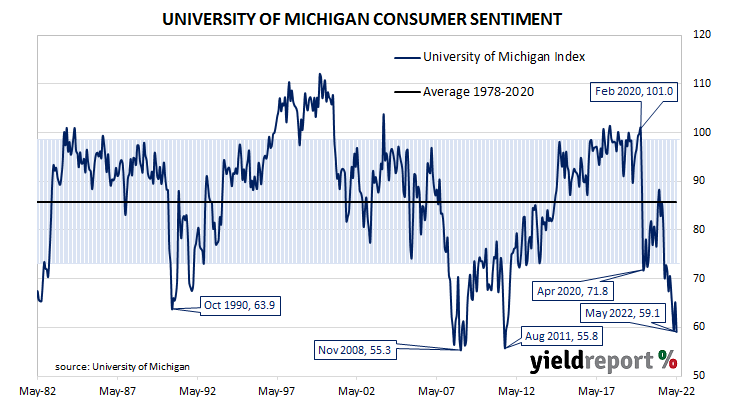Summary: University of Michigan consumer confidence index softens in May, below consensus expectations; views of present conditions, future conditions both deteriorate; declines across all demographic groups.
US consumer confidence started 2020 at an elevated level but, after a few months, surveys began to reflect a growing unease with the global spread of COVID-19 and its reach into the US. Household confidence plunged in April 2020 and then recovered in a haphazard fashion, generally fluctuating at below-average levels according to the University of Michigan. The University’s measure of confidence had recovered back to the long-term average by April 2021 but then it plunged again in the September quarter and has since remained at historically low levels.
The latest survey conducted by the University indicates confidence among US households softened on average in May. The preliminary reading of the Index of Consumer Sentiment registered 59.1, below the generally expected figure of 64.0 as well as April’s final figure of 65.2. Consumers’ views of current conditions and expectations regarding future conditions both deteriorated in comparison to those held at the time of the April survey.
The University’s Surveys of Consumers chief economist, Richard Curtin, noted declines in confidence across demographic groups. “These declines were broad based–for current economic conditions as well as consumer expectations, and visible across income, age, education, geography, and political affiliation–continuing the general downward trend in sentiment over the past year. “
Long-term US Treasury bond yields moved higher lower on the day. By the close of business, the 10-year Treasury yield had added 3bps to 2.92% and the 30-year yield had gained 6bps to 3.08%. The 2-year yield finished unchanged at 2.58%.
Less-confident households are generally inclined to spend less and save more; some decline in household spending could be expected to follow. As private consumption expenditures account for a majority of GDP in advanced economies, a lower rate of household spending growth would flow through to lower GDP growth if other GDP components did not compensate.


